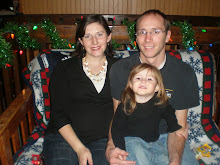Toddler-Proofing Checklist for Your Home | ||||||||||
| ||||||||||
Tuesday, November 24, 2009
Toddler-Proofing
Monday, November 9, 2009
Recalls!!
Maclaren USA Recalls to Repair Strollers Following Fingertip Amputations
Name of Product: Maclaren Strollers
Units: About one million
Distributor: Maclaren USA, Inc., of South Norwalk, Conn.
Hazard: The stroller's hinge mechanism poses a fingertip amputation and laceration hazard to the child when the consumer is unfolding/opening the stroller.
Incidents/Injuries: The firm has received 15 reports of children placing their finger in the stroller's hinge mechanism, resulting in 12 reports of fingertip amputations in the United States.
Description: This recall involves all Maclaren single and double umbrella strollers. The word "Maclaren" is printed on the stroller. The affected models included Volo, Triumph, Quest Sport, Quest Mod, Techno XT, TechnoXLR, Twin Triumph, Twin Techno and Easy Traveller.
Sold at: Babies"R"Us, Target and other juvenile product and mass merchandise retailers nationwide from 1999 through November 2009 for between $100 and $360.
Manufactured in: China
Remedy: Consumers should immediately stop using these recalled strollers and contact Maclaren USA to receive a free repair kit.
Consumer Contact: For additional information, contact Maclaren USA toll-free at (877) 688-2326 between 8 a.m. and 5 p.m. ET Monday through Friday or visit the firm's Web site at www.maclaren.us/recall
To see this recall on CPSC's web site, including pictures of the recalled product, please go to: http://www.cpsc.gov/cpscpub/prerel/prhtml10/10033.html
Name of Product: Maclaren Strollers
Units: About one million
Distributor: Maclaren USA, Inc., of South Norwalk, Conn.
Hazard: The stroller's hinge mechanism poses a fingertip amputation and laceration hazard to the child when the consumer is unfolding/opening the stroller.
Incidents/Injuries: The firm has received 15 reports of children placing their finger in the stroller's hinge mechanism, resulting in 12 reports of fingertip amputations in the United States.
Description: This recall involves all Maclaren single and double umbrella strollers. The word "Maclaren" is printed on the stroller. The affected models included Volo, Triumph, Quest Sport, Quest Mod, Techno XT, TechnoXLR, Twin Triumph, Twin Techno and Easy Traveller.
Sold at: Babies"R"Us, Target and other juvenile product and mass merchandise retailers nationwide from 1999 through November 2009 for between $100 and $360.
Manufactured in: China
Remedy: Consumers should immediately stop using these recalled strollers and contact Maclaren USA to receive a free repair kit.
Consumer Contact: For additional information, contact Maclaren USA toll-free at (877) 688-2326 between 8 a.m. and 5 p.m. ET Monday through Friday or visit the firm's Web site at www.maclaren.us/recall
To see this recall on CPSC's web site, including pictures of the recalled product, please go to: http://www.cpsc.gov/cpscpub/
Wednesday, November 4, 2009
The Great Meconium!
We recently had a question from a viewer concerning baby's first poo - the dreaded meconium. This nasty tar-looking bowel movement has often caused some confusion to first time parents.
According to The National Institute of Health, the Meconium is "a thick, sticky, greenish-black substance". It is composed of amniotic fluid, mucus, lanugo (the fine hair that covers baby's body), bile, and cells that have been shed from the skin and the intestinal tract.

According to The National Institute of Health, the Meconium is "a thick, sticky, greenish-black substance". It is composed of amniotic fluid, mucus, lanugo (the fine hair that covers baby's body), bile, and cells that have been shed from the skin and the intestinal tract.
"During pregnancy, the baby floats in the amniotic fluid that fills the mother's uterus. This fluid protects the baby while he or she grows and develops. The baby swallows the amniotic fluid, which contains all the other constituents mentioned above. All of the contents other than the amniotic fluid itself are filtered out and remain behind in the intestine while the amniotic fluid is absorbed and re-released into the uterine space when the fetus urinates. This cycle maintains the amniotic fluid in a clear, healthy state during the nine months of pregnancy. This process of recycling the amniotic fluid occurs about every 3 hours."

Subscribe to:
Posts (Atom)



